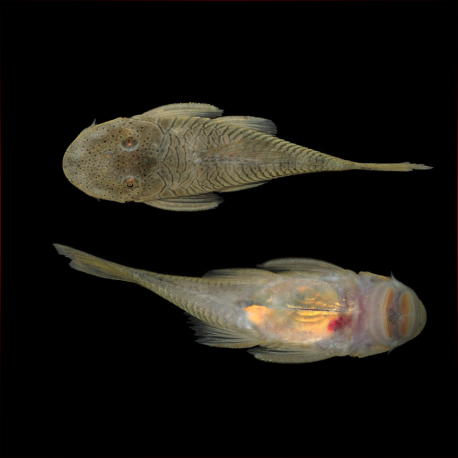More info
Datasheet
| Minimum Tank Size | 160 litres / 42.27 US gallons |
| Maximum Size | 10.5cm / 4.13inches |
| Temperature | 20°C / 68.00°F - 24°C / 75.20°F |
| Hardness | 8.01dgH / 143ppm - 25.04dgH / 447ppm |
| pH | 6.5-7.8 |
General Description:
The Chaetostoma Formosae, also known as the Striped Bulldog Pleco or L444, L187B, is the most common species within its genus in the aquarium trade. It is often confused with other species such as C. thompsoni or C. cf. thompsoni, but can be distinguished by features such as the enlarged second unbranched anal-fin ray. This species primarily feeds on aufwuchs, including algae, small crustaceans, and insect larvae, and requires a specialized diet to maintain optimal health and coloration.
Aquarium Setup:
To set up an aquarium suitable for Chaetostoma Formosae, it is essential to maintain clean, well-oxygenated water. A turnover rate of 10-15 times the tank volume per hour is recommended, along with the use of gravel, sand, or a mix of both as substrate. Providing water-worn rocks, pebbles, and aged driftwood can create a natural habitat for the pleco. Strong lighting is recommended to promote algae growth, and hardy aquatic plants like Microsorum and Anubias can be included. Regular water changes and allowing algae growth on tank surfaces are vital for the species.
Behaviour:
This species thrives in a dedicated tank setup, either alone or with compatible, peaceful tankmates. It can exhibit territorial behavior towards its own species and similarly-shaped fishes, requiring a well-structured tank with hiding spots and broken lines of sight. Chaetostoma Formosae is known to graze on algae as a significant part of its diet, and the availability of suitable foods is crucial for its well-being in captivity.
Feeding and Diet:
The Striped Bulldog Pleco primarily grazes on algae, small crustaceans, and insect larvae in its natural habitat. In an aquarium setting, it should be offered regular meals of small live and frozen foods such as bloodworms, Daphnia, and Artemia. While some specimens may accept sinking dried foods, fresh vegetables, and fruits, algae should remain a staple in their diet. Maintaining a separate tank to cultivate algae can be necessary if the main tank lacks sufficient growth.
Reproduction & Dimorphism:
Reports of captive spawning for Chaetostoma Formosae are limited, typically occurring in well-established tank setups. Males exhibit sexual dimorphism, with distinct physical characteristics such as an enlarged second unbranched anal-fin ray, fleshy ridges, and odontote development. Females differ in size and fin morphology, with biological variances particularly noticeable in the pelvic fins and genital area.
Habitat and Distribution:
This species is found in western piedmont streams within the upper río Meta and río Guaviare drainage systems in Colombia. It inhabits fast-flowing headwater streams with rocky substrates, clear and oxygenated water, and biofilm-rich surfaces. Chaetostoma Formosae is commonly collected near Villavicencio in the Meta department for the aquarium trade, often alongside the congener C. dorsale.

